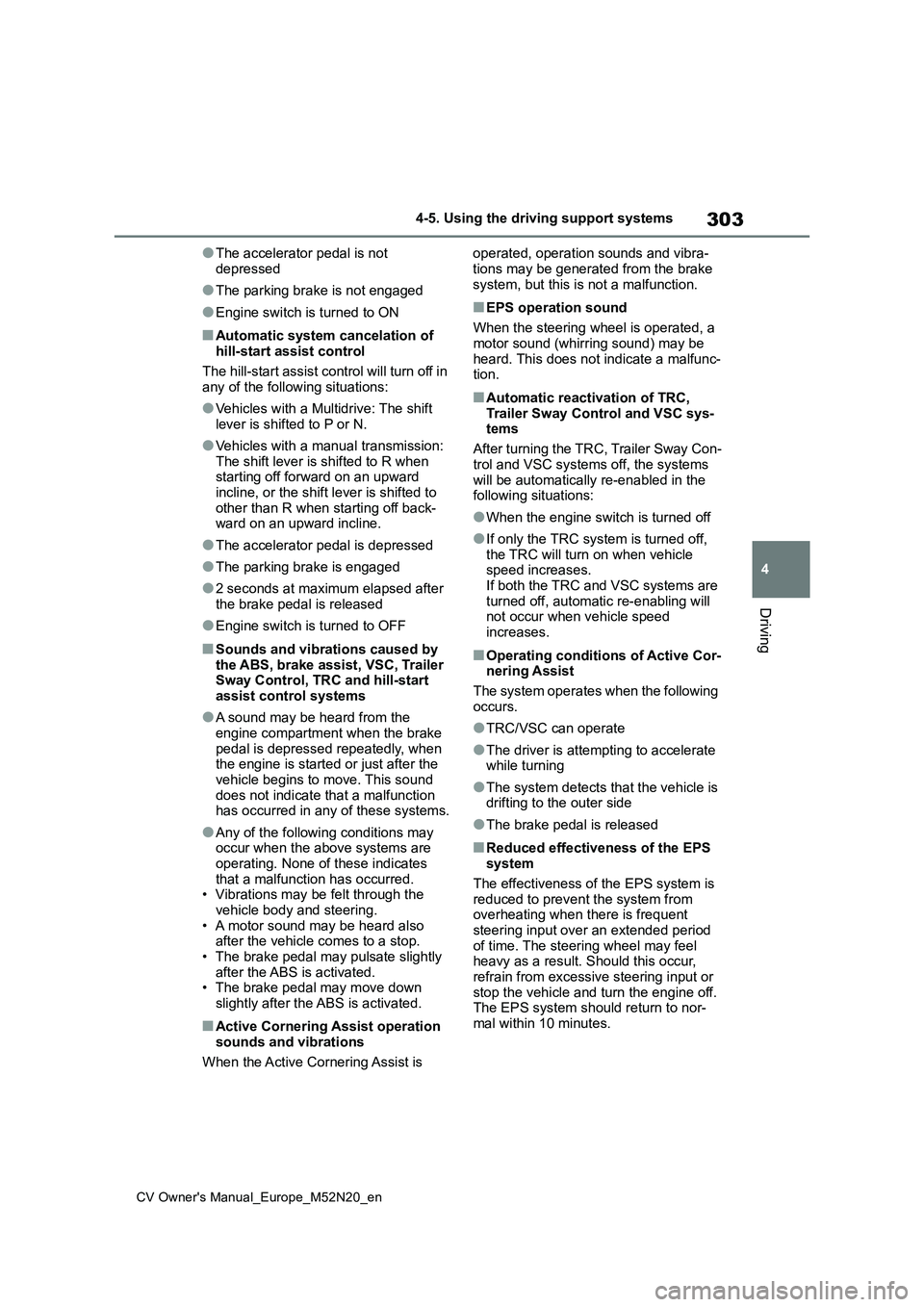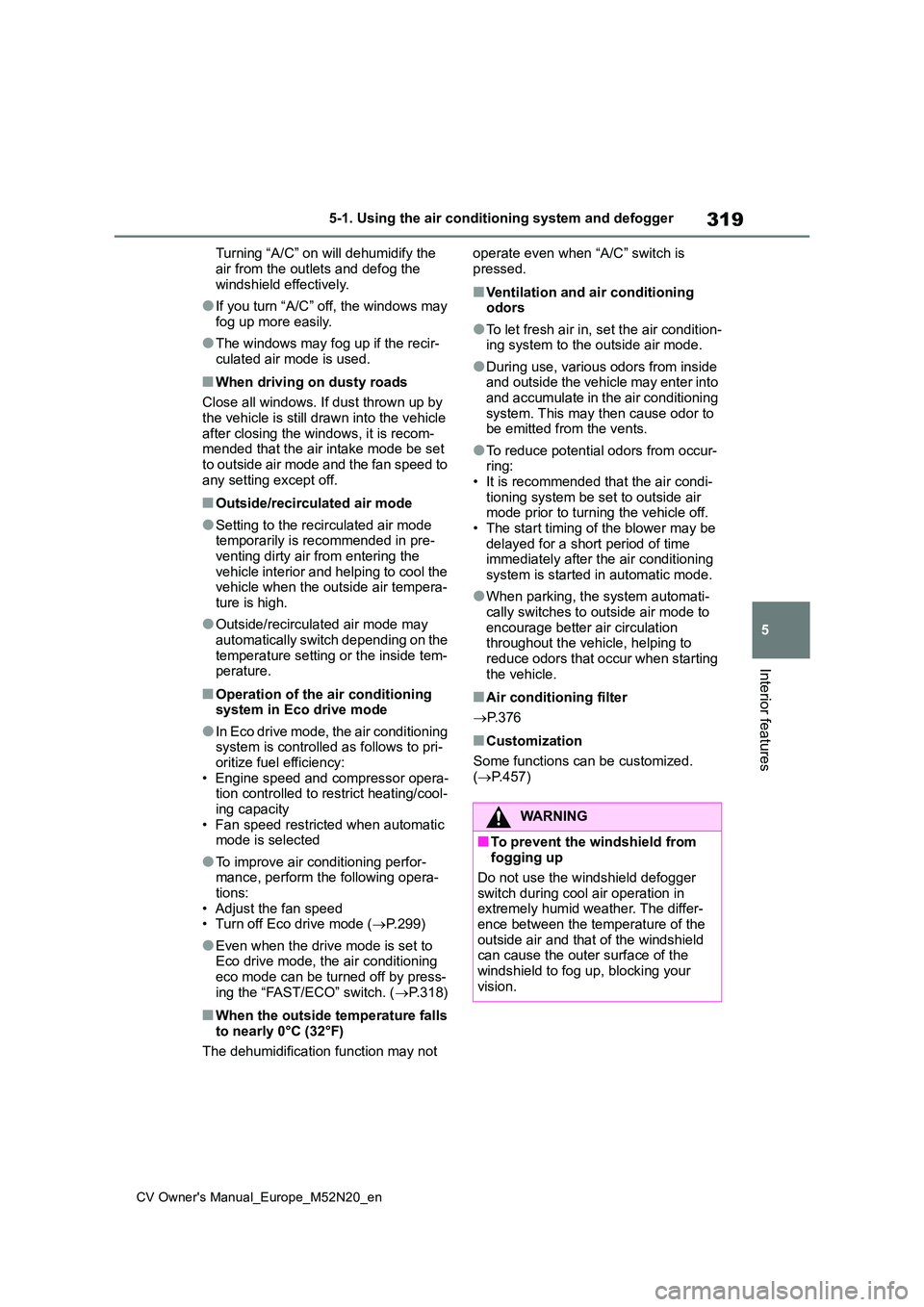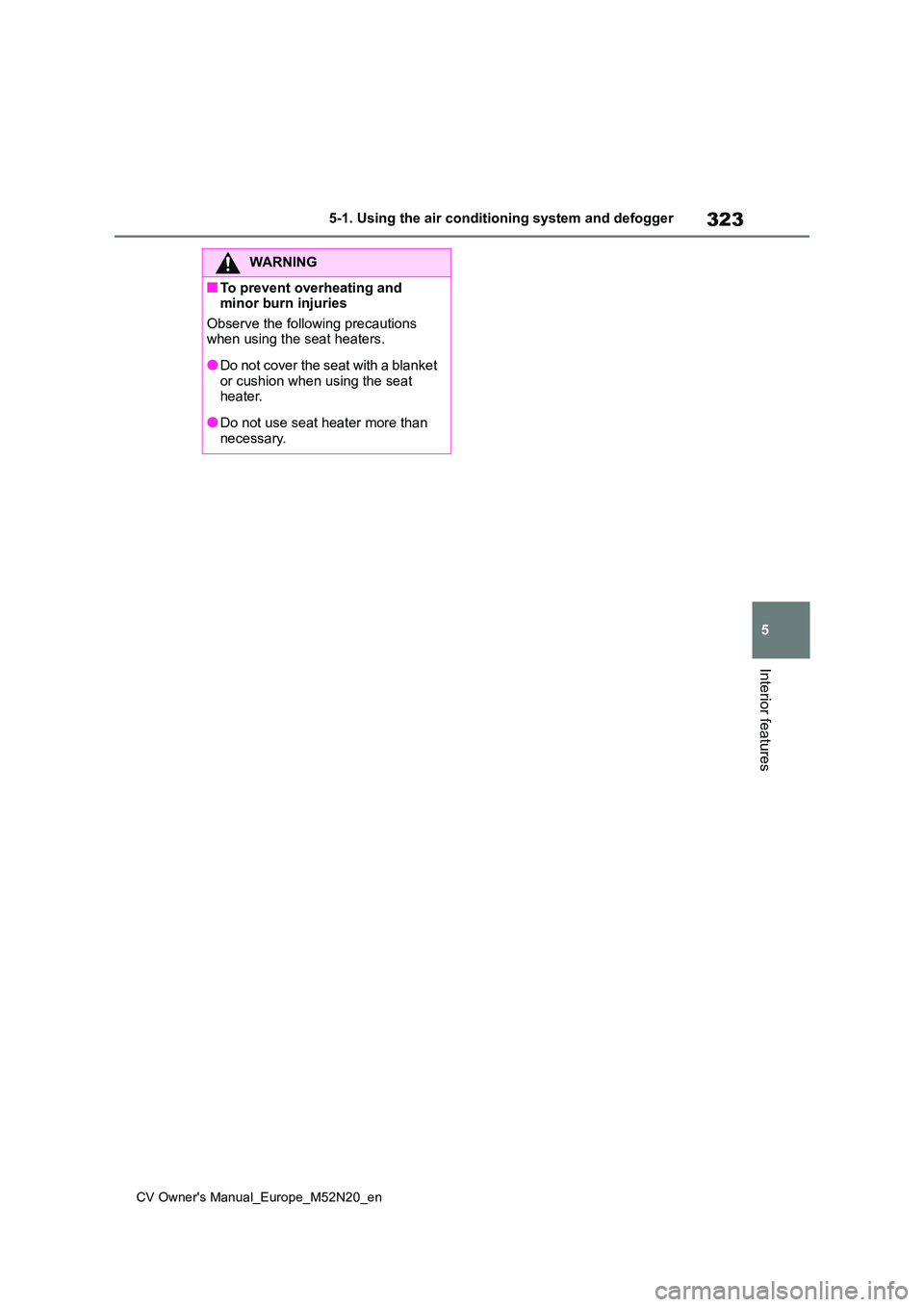2022 TOYOTA YARIS CROSS Heating manual
[x] Cancel search: Heating manualPage 191 of 618

189
4
CV Owner's Manual_Europe_M52N20_en
4-2. Driving procedures
Driving
■Parking the vehicle
P. 1 8 6
■Parking brake engaged warning buzzer
A buzzer will sound if the vehicle is
driven with the parking brake engaged. “Parking Brake ON” is displayed on the multi-information display. (with the vehi-
cle reached a speed of 5 km/h [3 mph])
■If the brake system warning light comes on
P. 4 0 3
■Usage in winter time
P. 3 0 8
WARNING
■When parking the vehicle
Do not leave a child in the vehicle
alone. The parking brake may be released unintentionally and there is the danger of the vehicle moving that
may lead to an accident resulting in death or serious injury.
■Parking brake switch
Do not set any objects near the park- ing brake switch.
Objects may interfere with the switch and may lead the parking brake to unexpectedly operate.
NOTICE
■When parking the vehicle
Before you leave the vehicle, set the parking brake, shift the shift lever to P and make sure that the vehicle does
not move.
■When the system malfunctions
Stop the vehicle in a safe place and check the warning messages.
■When the parking brake cannot be released due to a malfunction
Driving the vehicle with the parking
brake set will lead to brake compo- nents overheating, which may affect braking performance and increase
brake wear.
Have the vehicle inspected by any authorized Toyota retailer or Toyota
authorized repairer, or any reliable repairer immediately if this occurs.
Page 305 of 618

303
4
CV Owner's Manual_Europe_M52N20_en
4-5. Using the driving support systems
Driving
●The accelerator pedal is not
depressed
●The parking brake is not engaged
●Engine switch is turned to ON
■Automatic system cancelation of hill-start assist control
The hill-start assist control will turn off in any of the following situations:
●Vehicles with a Multidrive: The shift lever is shifted to P or N.
●Vehicles with a manual transmission: The shift lever is shifted to R when starting off forward on an upward
incline, or the shift lever is shifted to other than R when starting off back-ward on an upward incline.
●The accelerator pedal is depressed
●The parking brake is engaged
●2 seconds at maximum elapsed after
the brake pedal is released
●Engine switch is turned to OFF
■Sounds and vibrations caused by
the ABS, brake assist, VSC, Trailer Sway Control, TRC and hill-start assist control systems
●A sound may be heard from the engine compartment when the brake
pedal is depressed repeatedly, when the engine is started or just after the vehicle begins to move. This sound
does not indicate that a malfunction has occurred in any of these systems.
●Any of the following conditions may occur when the above systems are operating. None of these indicates
that a malfunction has occurred. • Vibrations may be felt through the vehicle body and steering.
• A motor sound may be heard also after the vehicle comes to a stop.• The brake pedal may pulsate slightly
after the ABS is activated. • The brake pedal may move down slightly after the ABS is activated.
■Active Cornering Assist operation
sounds and vibrations
When the Active Cornering Assist is
operated, operation sounds and vibra-
tions may be generated from the brake system, but this is not a malfunction.
■EPS operation sound
When the steering wheel is operated, a
motor sound (whirring sound) may be heard. This does not indicate a malfunc-tion.
■Automatic reactivation of TRC,
Trailer Sway Control and VSC sys- tems
After turning the TRC, Trailer Sway Con-
trol and VSC systems off, the systems will be automatically re-enabled in the following situations:
●When the engine switch is turned off
●If only the TRC system is turned off, the TRC will turn on when vehicle speed increases.
If both the TRC and VSC systems are turned off, automatic re-enabling will not occur when vehicle speed
increases.
■Operating conditions of Active Cor- nering Assist
The system operates when the following
occurs.
●TRC/VSC can operate
●The driver is attempting to accelerate while turning
●The system detects that the vehicle is drifting to the outer side
●The brake pedal is released
■Reduced effectiveness of the EPS system
The effectiveness of the EPS system is reduced to prevent the system from overheating when there is frequent
steering input over an extended period of time. The steering wheel may feel heavy as a result. Should this occur,
refrain from excessive steering input or stop the vehicle and turn the engine off. The EPS system should return to nor-
mal within 10 minutes.
Page 321 of 618

319
5
CV Owner's Manual_Europe_M52N20_en
5-1. Using the air conditioning system and defogger
Interior features
Turning “A/C” on will dehumidify the
air from the outlets and defog the windshield effectively.
●If you turn “A/C” off, the windows may fog up more easily.
●The windows may fog up if the recir-culated air mode is used.
■When driving on dusty roads
Close all windows. If dust thrown up by
the vehicle is still drawn into the vehicle after closing the windows, it is recom-mended that the air intake mode be set
to outside air mode and the fan speed to any setting except off.
■Outside/recirculated air mode
●Setting to the recirculated air mode temporarily is recommended in pre-venting dirty air from entering the
vehicle interior and helping to cool the vehicle when the outside air tempera-ture is high.
●Outside/recirculated air mode may automatically switch depending on the
temperature setting or the inside tem- perature.
■Operation of the air conditioning system in Eco drive mode
●In Eco drive mode, the air conditioning system is controlled as follows to pri-
oritize fuel efficiency: • Engine speed and compressor opera-tion controlled to restrict heating/cool-
ing capacity • Fan speed restricted when automatic mode is selected
●To improve air conditioning perfor-mance, perform the following opera-
tions: • Adjust the fan speed• Turn off Eco drive mode ( P.299)
●Even when the drive mode is set to Eco drive mode, the air conditioning
eco mode can be turned off by press- ing the “FAST/ECO” switch. ( P.318)
■When the outside temperature falls to nearly 0°C (32°F)
The dehumidification function may not
operate even when “A/C” switch is
pressed.
■Ventilation and air conditioning odors
●To let fresh air in, set the air condition-ing system to the outside air mode.
●During use, various odors from inside and outside the vehicle may enter into and accumulate in the air conditioning
system. This may then cause odor to be emitted from the vents.
●To reduce potential odors from occur-ring:• It is recommended that the air condi-
tioning system be set to outside air mode prior to turning the vehicle off.• The start timing of the blower may be
delayed for a short period of time immediately after the air conditioning system is started in automatic mode.
●When parking, the system automati-cally switches to outside air mode to
encourage better air circulation throughout the vehicle, helping to reduce odors that occur when starting
the vehicle.
■Air conditioning filter
P. 3 7 6
■Customization
Some functions can be customized.
( P.457)
WARNING
■To prevent the windshield from fogging up
Do not use the windshield defogger switch during cool air operation in extremely humid weather. The differ-
ence between the temperature of the outside air and that of the windshield can cause the outer surface of the
windshield to fog up, blocking your vision.
Page 325 of 618

323
5
CV Owner's Manual_Europe_M52N20_en
5-1. Using the air conditioning system and defogger
Interior features
WARNING
■To prevent overheating and minor burn injuries
Observe the following precautions when using the seat heaters.
●Do not cover the seat with a blanket or cushion when using the seat heater.
●Do not use seat heater more than necessary.
Page 444 of 618

442
CV Owner's Manual_Europe_M52N20_en
7-2. Steps to take in an emergency
1Stop the vehicle in a safe place
and turn off the air conditioning
system, and then stop the
engine.
2 If you see steam: Carefully lift
the hood after the steam sub-
sides.
If you do not see steam: Care-
fully lift the hood.
3 After the engine has cooled
down sufficiently, inspect the
WARNING
●When working with the battery, always wear safety glasses and
take care not to allow any battery fluids (acid) to come into contact with skin, clothing or the vehicle
body.
●Do not lean over the battery.
●In the event that battery fluid comes into contact with the skin or eyes,
immediately wash the affected area with water and seek medical atten-tion. Place a wet sponge or cloth
over the affected area until medical attention can be received.
●Always wash your hands after han-dling the battery support, terminals, and other battery-related parts.
●Do not allow children near the bat-tery.
■When replacing the battery
●When the vent plug and indicator
are close to the hold down clamp, the battery fluid (sulfuric acid) may leak.
●For information regarding battery replacement, contact any autho-
rized Toyota retailer or Toyota authorized repairer, or any reliable repairer.
NOTICE
■When handling jumper cables
When connecting the jumper cables,
ensure that they do not become entangled in the cooling fan or engine drive belt.
If your vehicle overheats
The following may indicate that
your vehicle is overheating.
The engine coolant tempera-
ture gauge ( P.85, 89) is in
the red zone or a loss of
engine power is experienced.
(For example, the vehicle
speed does not increase.)
“Engine Coolant Temp High
Stop in a Safe Place See
Owner’s Manual” is shown on
the multi-information display.
Steam comes out from under
the hood.
Correction procedures
Page 476 of 618

474
CV Owner's Manual_Europe_M52N20_en
Alphabetical Index
Blind Spot Monitor (BSM) ............ 272
Enabling/disabling the Blind Spot
Monitor..................................... 274
Bottle holders ............................... 327
Brake
Brake hold .................................. 190
Emergency brake signal ............ 301
Fluid ........................................... 453
Parking brake ............................. 186
Warning light .............................. 403
Brake assist .................................. 301
Break-in tips .................................. 160
Brightness control
Instrument panel light control . 88, 93
BSM (Blind Spot Monitor) ............ 272
Enabling/disabling the Blind Spot
Monitor..................................... 274
C
Care ....................................... 342, 345
Aluminum wheels ....................... 342
Exterior....................................... 342
Interior ........................................ 345
Seat belts ................................... 345
Chains ........................................... 308
Child restraint system .................... 49
Points to remember...................... 49
Riding with children ...................... 48
Child safety ..................................... 48
Airbag precautions ....................... 43
Back door precautions ............... 123
Battery precautions ............ 361, 441
Child restraint system .................. 49
Heated steering wheel and seat
heater precautions ................... 322
How your child should wear the seat
belt ............................................. 36
Installing child restraints............... 49
Power window lock switch.......... 155
Power window precautions ........ 154
Rear door child-protectors.......... 123
Removed electronic key battery pre-
cautions.................................... 380
Seat belt precautions ................... 48
Child-protectors ............................ 123
Cleaning................................. 342, 345
Aluminum wheels .......................342
Exterior ....................................... 342
Interior ........................................345
Radar sensor.............................. 213
Seat belts ...................................345
Clock ........................85, 87, 88, 89, 93
Coat hooks .................................... 339
Condenser ..................................... 357
Console box .................................. 328
Consumption screen .................... 110
Cooling system .............................356
Engine overheating .................... 442
Cruise control
Dynamic radar cruise control ..... 250
Dynamic radar cruise control with
full-speed range .......................238
Cup holders ...................................327
Current fuel consumption ......96, 101
Curtain shield airbags ....................38
Customizable features ................. 457
D
Daytime running light system ..... 192
Deck board .................................... 329
Defogger
Outside rear view mirrors ... 313, 318
Rear window ...................... 313, 318
Windshield.......................... 313, 318
Dimensions ...................................448
Page 478 of 618

476
CV Owner's Manual_Europe_M52N20_en
Alphabetical Index
If you have a flat tire........... 415, 426
If you lose your keys .................. 436
If you think something is wrong.. 401
If your vehicle becomes stuck .... 444
If your vehicle has to be stopped in
an emergency .......................... 394
If your vehicle needs to be towed
................................................. 397
If your vehicle overheats ............ 442
Engine ........................................... 449
ACC ................................... 173, 177
Compartment ............................. 354
Engine switch ..................... 173, 174
Fuel pump shut off system ......... 402
Hood .......................................... 351
How to start the engine ...... 173, 174
Identification number.................. 449
If the engine will not start ........... 435
If your vehicle has to be stopped in
an emergency .......................... 394
Ignition switch (engine switch) . 173,
174
Overheating ............................... 442
Tachometer .................... 85, 89, 109
Engine coolant .............................. 356
Capacity ..................................... 452
Checking .................................... 356
Preparing and checking before win-
ter ............................................ 307
Engine coolant temperature gauge
................................................. 85, 89
Engine immobilizer system ........... 75
Engine oil ...................................... 354
Capacity ..................................... 450
Checking .................................... 354
Preparing and checking before win-
ter ............................................ 307
Warning light .............................. 404
Engine oil maintenance data ....... 356
Engine switch........................ 173, 174
Auto power off function .............. 177
Changing the engine switch modes
......................................... 173, 177
If your vehicle has to be stopped in
an emergency .......................... 394
EPS (Electric Power Steering) ..... 301
Warning light .............................. 406
Extended headlight lighting function
..................................................... 194
F
Flat tire
Tire pressure warning system .... 364
Vehicles with a spare tire ........... 426
Vehicles without a spare tire ...... 415
Floor mats ....................................... 32
Fluid
Brake .......................................... 453
Clutch ......................................... 453
Multidrive .................................... 452
Washer ....................................... 362
Fog lights
Switch......................................... 204
Wattage ...................................... 455
Front fog lights
Switch......................................... 204
Wattage ...................................... 455
Front position lights
Replacing light bulbs ..................387
Wattage ...................................... 455
Front seat center airbags ............... 38
Front seats .................................... 141
Adjustment ................................. 141
Cleaning ..................................... 345
Correct driving posture ................. 33
Head restraints ........................... 144
Seat heaters ............................... 322
Page 482 of 618

480
CV Owner's Manual_Europe_M52N20_en
Alphabetical Index
N
Navigation system-linked display97,
103, 106
O
Odometer .................................. 87, 92
Odometer and trip meter display
Display change button ........... 87, 92
Display items.......................... 87, 92
Oil
Engine oil ................................... 450
Manual transmission .................. 453
Opener
Back door ........................... 125, 127
Fuel filler door ............................ 210
Hood .......................................... 351
Outside rear view mirrors
Adjustment ................................. 150
BSM (Blind Spot Monitor) .......... 272
Folding ....................................... 151
Outside rear view mirror defoggers
......................................... 313, 318
RCTA (Rear Crossing Traffic Alert)
................................................. 284
Outside temperature ........ 85, 89, 109
Overheating .................................. 442
P
Paddle shift switches ................... 181
Panoramic roof shade .................. 339
Parking assist sensors (Toyota park-
ing assist-sensor) ...................... 277
Parking brake ................................ 186
Brake system warning light ........ 403
Operation ................................... 186
Parking brake engaged warning
buzzer ...................................... 189
Warning light .............................. 410
Warning message ...................... 189
Parking Support Brake (PKSB) ... 289
Enabling/disabling the Parking Sup-
port Brake ................................ 291
Parking Support Brake function
(rear-crossing vehicles)............297
Parking Support Brake function
(static objects) .......................... 294
Warning lights.............................409
Warning message ...................... 293
PCS (Pre-Collision System) ......... 217
Enabling/disabling the pre-collision
system...................................... 221
Function ..................................... 217
Warning light .............................. 409
Personal lights .............................. 324
Wattage ...................................... 455
PKSB (Parking Support Brake) ... 289
Enabling/disabling the Parking Sup-
port Brake ................................ 291
Parking Support Brake function
(rear-crossing vehicles)............297
Parking Support Brake function
(static objects) .......................... 294
Warning lights.............................409
Warning message ...................... 293
Power back door opener switch.. 127
Power mode .................................. 299
Power outlet .................................. 333
Power steering (Electric power
steering system) ......................... 301
Warning light .............................. 406
Power windows
Door lock linked window operation
................................................. 154
Jam protection function .............. 153
Operation ...................................153
Window lock switch .................... 155